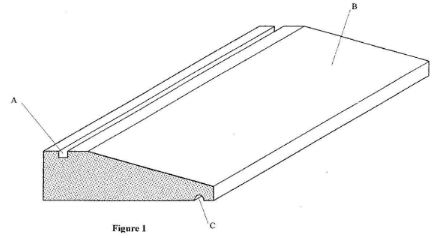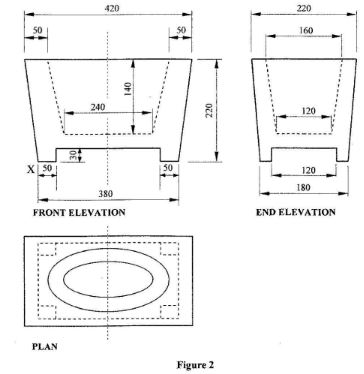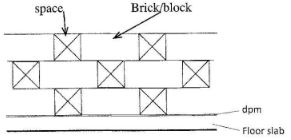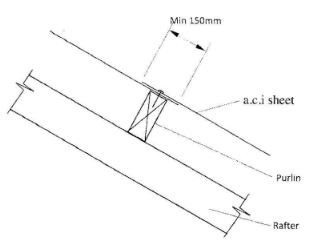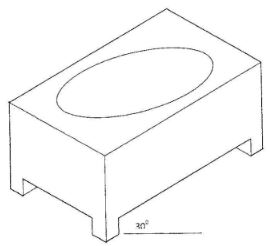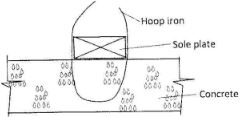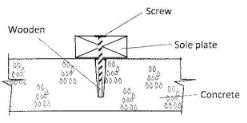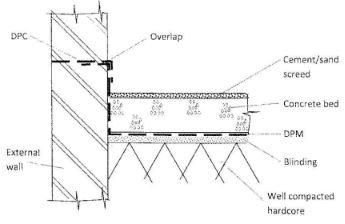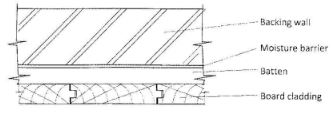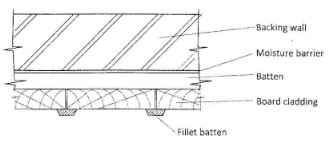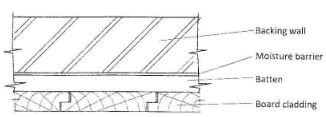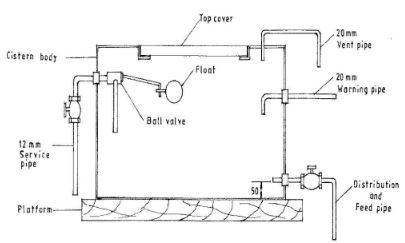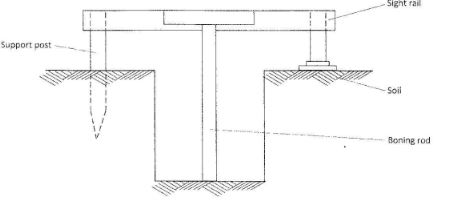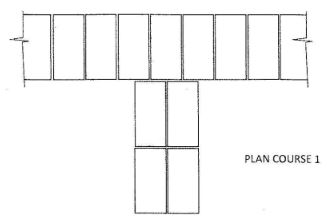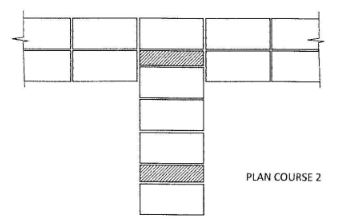BUILDING CONSTRUCTION
SECTION A (40 marks)
Answer all the questions in this section.
-
- Name two setting out equipment that are used for setting out corners of buildings.(1 mark)
- Name two types of foundations and state the type of soil in which each may be used.(2 marks)
-
- State two reasons for discouraging the use of very fine aggregate in a concrete mix.(1 mark)
- Make a labelled elevational sketch of a three course honeycomb wall,(3 marks)
-
- State four functions of oversite concrete.(2 marks)
- Differentiate between damp proof course and damp proof membrane with respect to moisture movement.(2 marks)
-
-
- Define the term scalfold.(1 mark)
- Name two types of scalfolds and state one example in each case.(2 marks)
- Outline four factors that will influence the positioning of a pit latrine on a site.(2 marks)
-
-
- List two tools used for landscaping.(1 mark)
- Figure 1 shows a window sill. Name the parts labelled A, B and C, giving the function of each part.(3 marks)
-
-
- State two items of safety wear worn on site.(1 mark)
- Give two types of inspection which are carried out before work commences in a trench 1.5 metres deep.(2 marks)
- Sketch a section of a roof to show the minimum lap of iron sheets at a purlin. -(2 marks)
-
-
- Sketch two sections of timber skirtings showing the treatment given to the top edges.(2 marks)
- Give two reasons that determine the rating of bulbs to be fitted in a room.(2 marks)
- A kitchen floor is to receive a terrazzo finish. Describe the procedure of laying the floor finish.(3 marks)
- Outline two functions of each of the following roof truss members:
- rafter(2 marks)
- tie beam.(2 marks)
- Using a pair of compasses and a ruler only, construct a triangle whose base length AB 120mm, angle CAB = 60° and angle ABC = 45° hence inscribe a circle touching all the sides.(4 marks)
SECTION B (60 marks)
Answer question 11 and any other three questions from this section.
Candidates are advised to spend not more than 25 minutes on question 11
- Figure 2 shows orthographic views of a vase drawn in first angle projection. To a scale of 1:1, draw an isometric view of the vase with point X as the lowest point.(15 marks)
-
- With the aid of sketches, outline two methods of anchoring the sole plate of a timber wall frame on a concrete floor bed.(11 marks)
- Using a sketch, explain how to construct a public footpath using concrete slabs.(4 marks)
-
- With the aid of a labelled sketch, show the damp proofing details at a junction of a floor slab and an external wall.(6 marks)
- Sketch and label horizontal sections to show two methods of fixing a vertical timber cladding on a wall.(9 marks)
-
- Sketch and label a vertical section through a cold water storage cistern.(9 marks
- With the aid of a labelled sketch, explain how a boning rod and a site rail are used to level a trench bottom.(6 marks)
-
- Outline the procedure of:
- obtaining a representative sample of sand from a large heap;(5 marks)
- fixing trusses into position to form a roof.(4 marks)
- Sketch alternate plan courses to show the bonding details of a T-junction wall in English Bond.(6 marks)
- Outline the procedure of:
MARKING SCHEME
-
- Tools/equipment for setting out corners:
- site square
- builders square
- dumpy level
- theodolite
(Any 2 x 1/2 = 1 mark)
- Types of foundations:
Name of foundation Type of soil Natural
Strip
Pad
Pile
Raft
(Any 2 x 1/2 = 1 mark)Rock
Hard/firm soil
Hard/firm soil
Weak soil
Peat, wet clay soil
(Any 2 x 1/2 = 1 mark)
- Tools/equipment for setting out corners:
-
- Reasons for discouraging the use of fine aggregates:
- to reduce drying shrinkage
- to check against reduced strength
- to reduce the amount of cement used
(Any 2 x 1/2 = 1 mark)
- Honey comb wall:
Spaces - 1/2 mark
Correct bonding - 1/2 mark
Labels Any 4 x 1/2 =2 marks
Total = 3 marks
- Reasons for discouraging the use of fine aggregates:
-
- Functions of over site concrete:
- provide a firm base on which to lay floor finishes
- provide a level surface
- prevent growth of vegetation
- prevent ingress of moisture from soils below
- thermal insulation
- sound proofing
(Any 4 x 1/2 = 2 marks)
- Damp Proof Course (DPC) is used in a building to provide a barrier to the passage of moisture from an external source into the fabric of a building vertically/through the wall.
Damp Proof Membrane (DPM) is used to prevent the passage of moisture from the lower part of ground to the upper surface of the floor. (2x 1 = 2 marks)
- Functions of over site concrete:
-
- Scaffolds
- A scaffold is a temporary structure which is erected to provide access/enable the workers, materials and equipment get to heights which cannot be reached from the ground.
(1 x 1 = 1 mark) - Independent e.g. tower, trestle
(types 2 x 1/2 = 1 mark) - Dependent e.g. putlog, cantilever
(example 2 x 1/2 = 1 mark)
(Total = 3 marks)
- A scaffold is a temporary structure which is erected to provide access/enable the workers, materials and equipment get to heights which cannot be reached from the ground.
- Four factors that will influence the positioning of a pit latrine on a site
- wind direction
- slope of land
- distance to wells
- Security to the users
(4 x 1/2 = 2 marks)
- Scaffolds
-
- Two tools used for landscaping
- jembe
- panga
- rake
- fork
- Mattock
(Any 2 x 1/2 = 1 mark)
- Function of parts of a window sill
- A - Joggel - for mixing window frames and water seals
- B - Slope - for shedding off water
- C - Throat - for dripping off water
(Naming 3 x 1/2 = 1 1/2 marks)
(Functions 3 x 1/2=1 1/2 marks)
- Two tools used for landscaping
-
-
- Items of safety wear worn on site:
- helmet
- overall
- overcoat/apron
- boots
- muffles
- goggles
(Any 2 x 1/2 = 1 marks)
- Types of inspection before work commences in a deep trench:
- collapse of the trench sides
- cracks on the trench sides
- timber supports to the trench sides
- water in the trench bottom
- levelling
(Any 2 x 1=2 marks)
- Items of safety wear worn on site:
-
Sketch = 1 mark
Lap 150 min =1/2
Nail Position = 1/2
(Total = 2 marks)
-
-
- SKIRTINGS - treatment to edges
Sketching = 1 mark
Naming =1 mark
(2 marks) - Reasons for determining rating of bulbs:
- function of the room
- decoration of the room
- size of the room
- size of openings in the room.
(Any 2 x 1 = 2 marks)
- SKIRTINGS - treatment to edges
- Procedure of laying terrazzo:
- prepare the background
- lay the cement-sand screed
- lay the dividing strips
- mix, place and compact the terrazzo
- grind and clean the floor finish(3 marks)
- Functions of roof truss members:
- Rafters
- distribute loads from roof to load bearing walls
- provides the pitch for the roof
- holds other members together
(Any 2 x l = 2 marks)
- Tie beam
- tying the truss
- fixing of brandering and ceiling
- supporting the water cistern
- supporting service pipes for water and electricity for
(Any 2 x 1 = 2 marks)
- Rafters
-
Construction
Line AB = 120mm = 1/2 mk
CAB = 60º = 1/2 mk
CBA = 45º = 1/2 mk
Point C = 1/2 mk
Bisectors at A&B = 1 mk
Inscribed circle = 1 mk
Total = 4 mks -
- 6 surfaces Any 6x2 = 3 marks
- Construction details
- Isometric
- Ellipse
- major axis 2 offsets (2 x 1/2)
- minor axis 2 offsets (2 x 1/2)
- smooth curve of ellipses
- Taper on 4 edges
- Correct scale
- Outlines (boid)
- Lowest point 'X' =15 marks
-
- Methods of anchoring the sole plate of a timber wall frame:
- using J-bolt
- mark the position of the sole plate
- cap the J-bolt in position during concreting
- mark the position of bolt on the sole plate and drill
- plug and fix sole plate with nuts
- using strap/hoop irons:
- hoop irons are cost in site during the concreting stage
- sole plate is positioned
- hoop irons are stretched and nailed onto the sole plate
- using wooden plug:
- drill holes on the concrete bed to accommodate the wooden plugs
- drive wooden plugs into the holes
- position the sole plate and secure onto wooden plugs with nails or screws
- Name - 1/2
Sketch= 2 1/2
Labels = 2 x 1/2=1
Explanation = 3 x 1/2=1 1/2
Total = 5 1/2
Any 2 x 5 1/2 = (11 marks)
- Name - 1/2
- using J-bolt
- Public Footpath
- compact the levelled natural ground
- lay kerbs and drainage channel
- lay and compact sand bedding to required fall
- lay paving slabs
- fill joints with mortar
- Sketch = 2 marks
Explanation = 2 marks
(Accept other appropriate sketches) = 4 marks
- Sketch = 2 marks
- Methods of anchoring the sole plate of a timber wall frame:
-
- Damproofing details at function of floor slabs and external wall
- Sketch = 2 1/2
Labels Any 4 x 1/2 = 2
Damproofing - Correct DPC position = 1/2
Correct DPM position = 1/2
Overlap = 1/2
Total = 6 marks
- Sketch = 2 1/2
- Methods of providing vertical timber cladding
- Tongue and groove
- Using butt joint
- Using rebated joint
- ANY TWO METHODS SKETCHED
Mthod - 2 x 1/2 = 1 mark
Sketch 2 x 2 - 4 marks
Labels Any 4 x 2 x 2 = 4 marks
Total 9 marks
- ANY TWO METHODS SKETCHED
- Tongue and groove
- Damproofing details at function of floor slabs and external wall
-
-
- Sketching = 5 marks.
Labelling Any 8x2 = 4 marks
9 marks
- Sketching = 5 marks.
-
- Explanation
- Establish level at sight rail
- Establish level at sighting rod
- Use travelling rod to establish intermediate levels
- Sketching = 3 marks
Labels 3 x 1/2 = 1 1/2
Explanation - 3 x 1/2 = 1 1/2
Total = 6 marks
- Explanation
-
-
- Procedure of obtaining a representative sample of sand:
- select a large sample from a given heap and pour it on a flat surface
- divide the sample into four equal parts (quarters)
- select diametrically diagonally opposite quarters and reject the test
- mix and pour the selected sample to form a cone
- repeat the quartering procedure until a representative sample is obtained
(5 marks)
- Procedure of fixing trusses into position to form a roof:
- mark the position of the trusses
- place the trusses in the marked positions
- fix the end trusses plumb
- brace the trusses
- tie the strings for alignment in order to align the remaining trusses into position
- fix the intermediate trusses into position with appropriate braces as you maintain the plumpness (4 marks)
-
PLAN COURSE 1
PLAN COURSE 2
- Procedure of obtaining a representative sample of sand:
Download KCSE 2011 Building Construction Paper 1 Questions with Marking Scheme.
Tap Here to Download for 50/-
Get on WhatsApp for 50/-
Why download?
- ✔ To read offline at any time.
- ✔ To Print at your convenience
- ✔ Share Easily with Friends / Students

